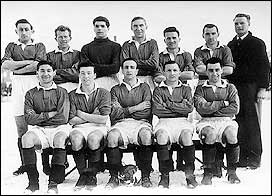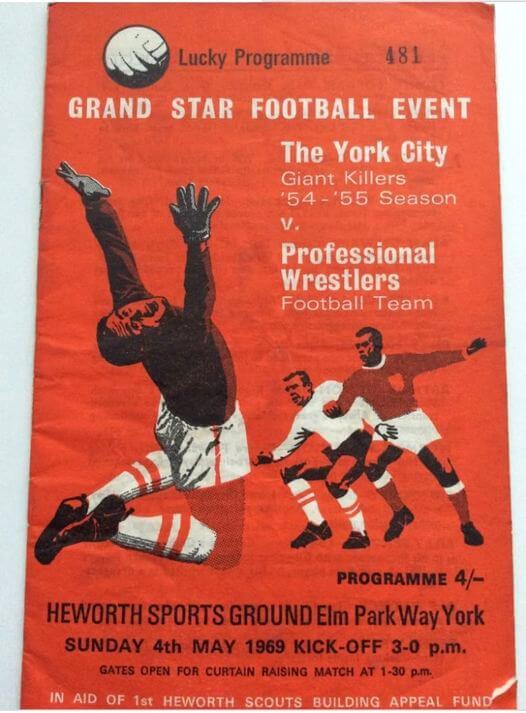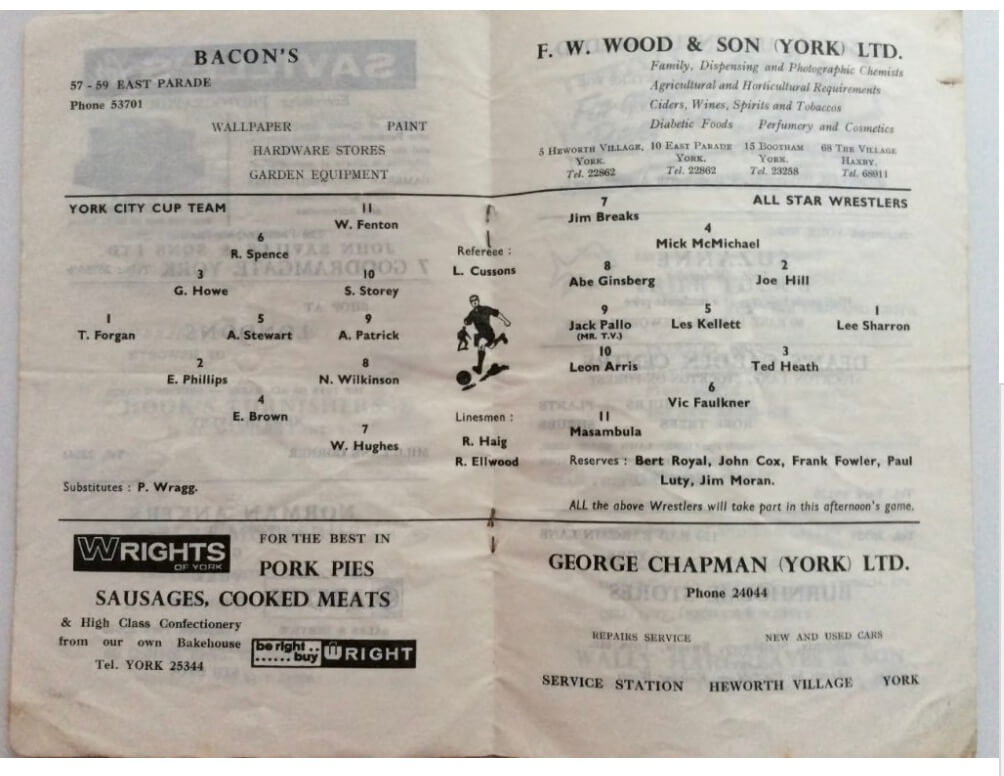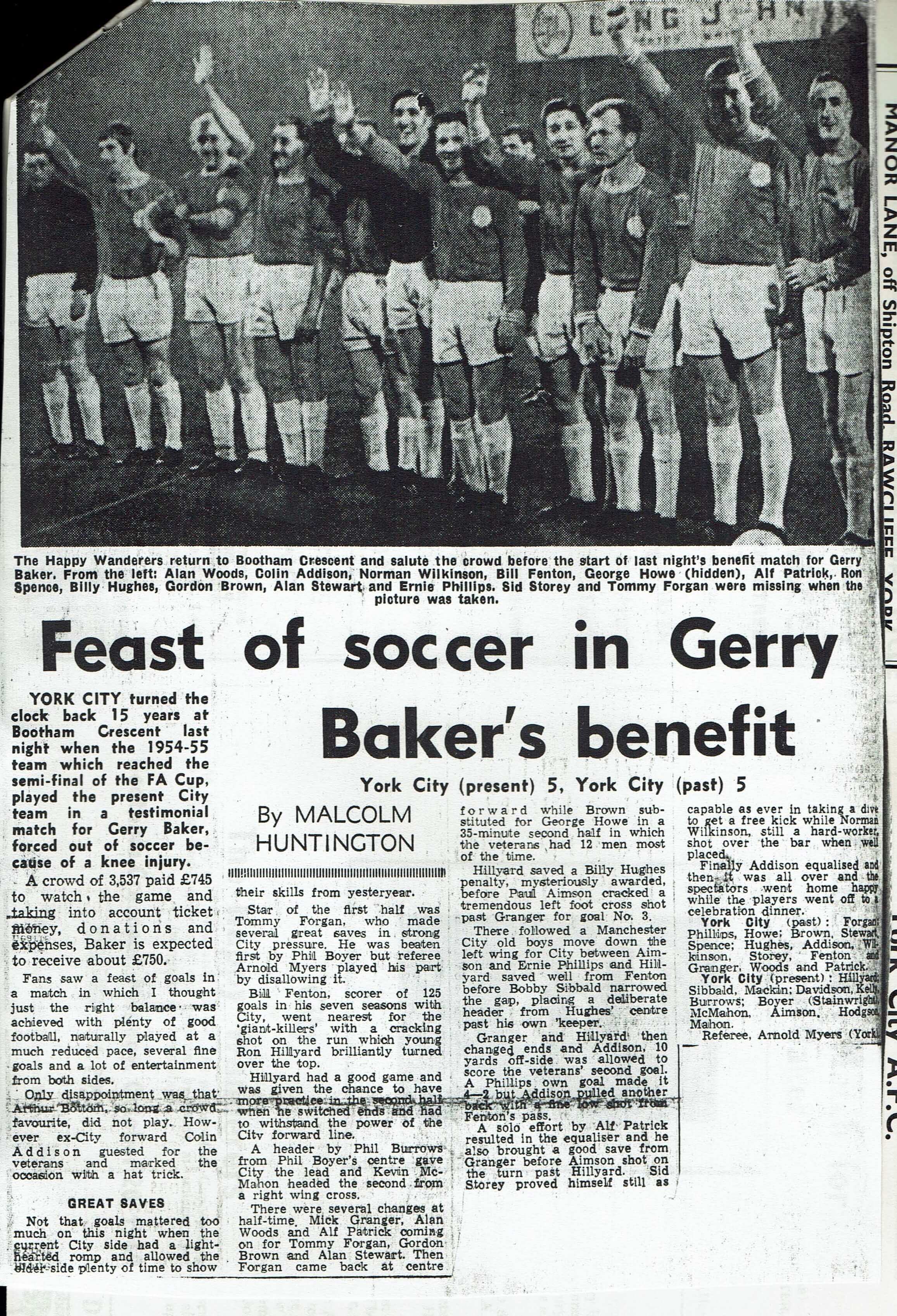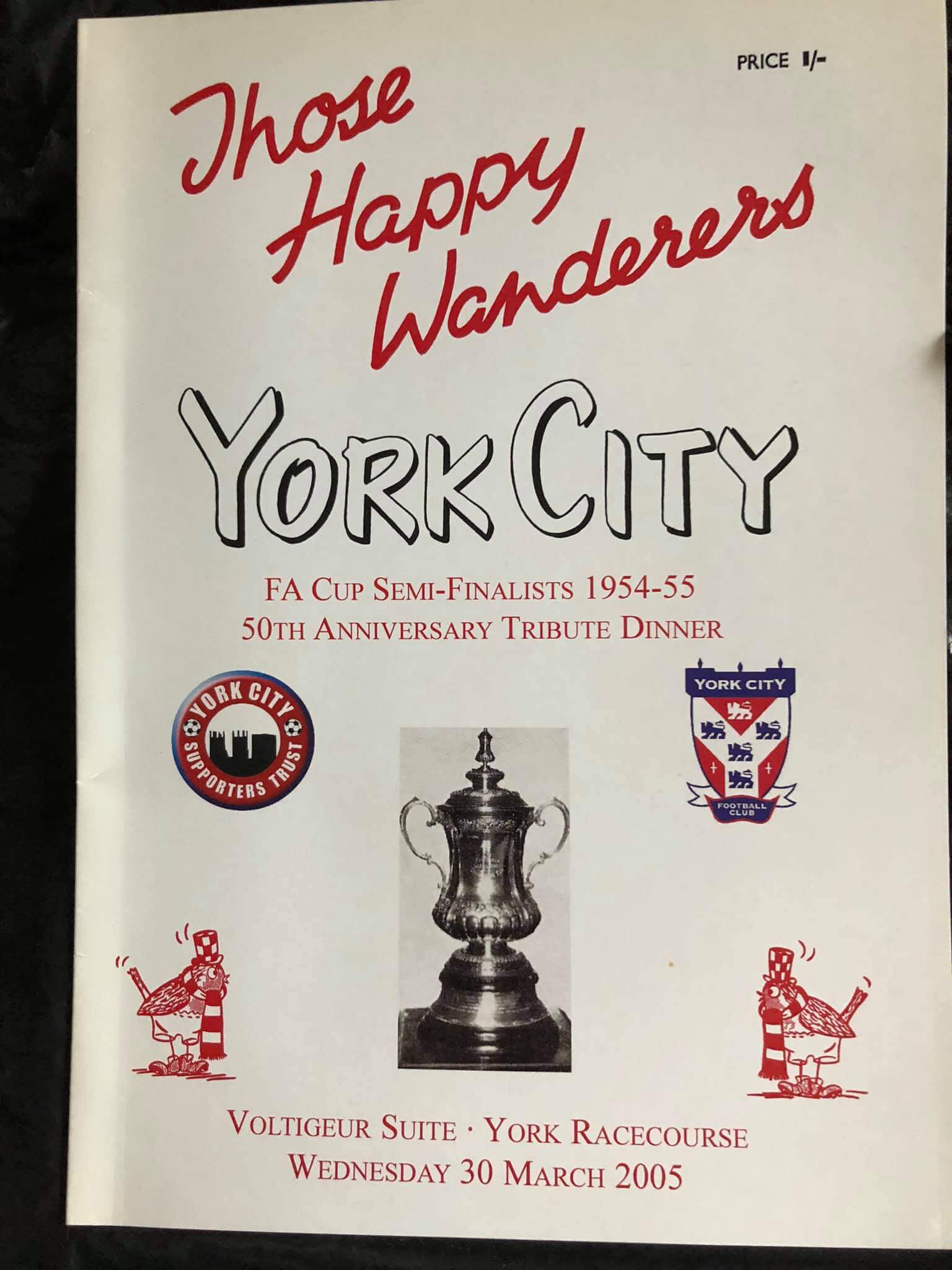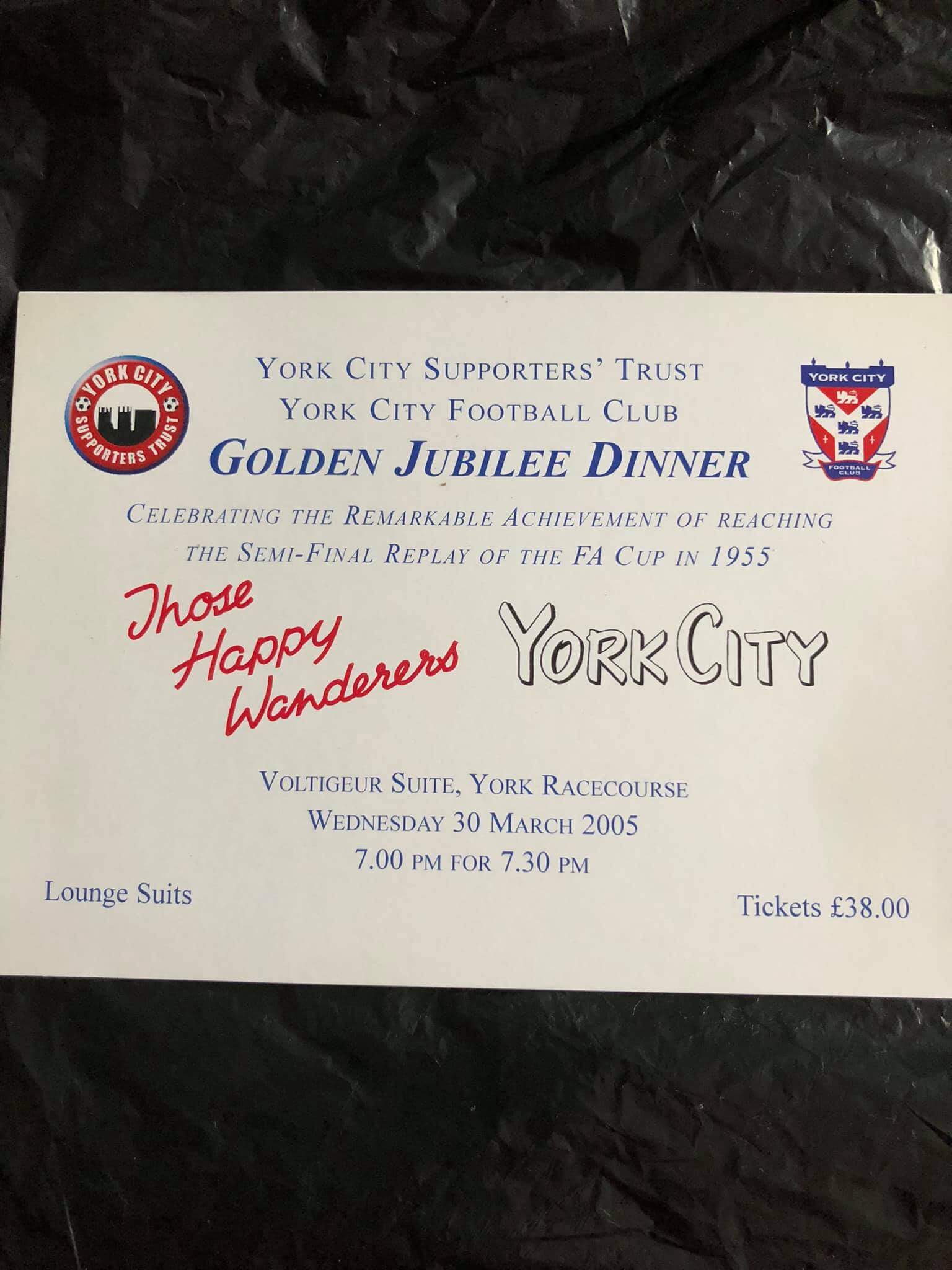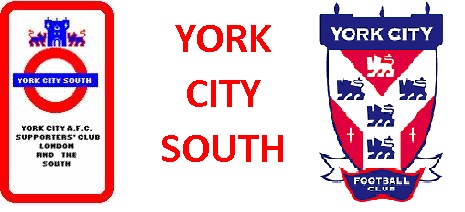

1954/5 FA Cup: York City, the little football club that reached the semi final of the FA Cup
1938
1955. City's FA Cup credentials had already been set. In 1938 we reached Round 6 when we took the mighty Huddersfield to a replay. Mighty in that in 1926, they'd won their third successive English Division 1 title, the first team ever to win it in 3 successive seasons. We drew 0-0 at home, in front of our all time record crowd of 28,123.
Watch the 1938 action on the links below (PS free registration maybe required). City v Huddersfield. Note the fans spilling onto the pitch and the original Main Stand, a fourth section was added after our 1955 FA Cup run. We lost the
replay. Read More: 1938 FA Cup run
1955 - The Happy Wanderers For the 1954/5 season, City underwent a significant re-building exercise in the summer. Having sold David Dunmore for a club record fee of £10,750 in February 1954, Dunmore later said that his transfer fee was spent on summer signings (Arthur Bottom, Tommy Forgan, George Howe, Ernie Phillips and Norman Wilkinson) that formed the back bone of City's 1954/5 Happy Wanderers FA Cup side, in reality, probably less than half the Dunmore fee was re-invested.
The newcomers were all experienceed pros, if not regular starters, aged between 23 and 30, dropping down the divisions. 3 came from Division 2 Hull City (Tommy Forgan, Norman Wilkinson and captain Ernie Phillips) whilst another 3 arrived from top flight clubs Sheffield United (Arthur Bottom and Sam McNab) and Huddersfield (George Howe).
The regular starting side contained 4 part time players (Gordon Brown, Billy Fenton, Sid Storey and Norman Wilkinson).
The recruitment reaped instant rewards, a stunning 6-2 win at Wrexham on the opening day of the season. All the goals coming from new signings, an Arthur Bottom hat trick, a Norman Wilkinson brace and one from Sam McNab.
An early season dispute between manager Jimmy McCormick and the board over team selection resulted in the manager’s resignation. City remained managerless for the next 18 months, team affairs being undertaken by trainer Tom Lockie and club secretary Billy Sherrington. An 8 game winless run followed before the restoration of Billy Hughes (back in York in October after returning, disillusioned, to Glasgow after the previous season) and Sid Storey (out of favour) to the side heralded a change in fortunes and a much more expansive attacking style of play which had the crowds flocking back to Bootham Crescent. In Round 1, City overcame Scarborough in a tense 3-2 local derby. Some said it was City’s hardest game in the cup run, as City twice came from behind to win 3-2 against the visitors who were buoyed by a large ex City contingent on the pitch and a vociferous support in the 10,155 crowd. To avoid a colour clash, as was the regulations of the time, both teams changed colours, City played in blue and white and Boro in yellow and black. In Round 2, City were on their travels, all the way to Dorset, a 2 night stay in Bournemouth followed by an encounter with Western League Dorchester Town. The small City contingent was regally entertained as Dorchester hosted league opposition for the first time ever. The Dorset Regiment band played “On Ilkla Moor Baht At” whist our directors were entertained in a specially erected marquee. Again City went behind, but equalised before half time. A pivotal moment occurred early in the second half as Dorchester’s centre half was injured and returned to play as nuisance value on the right wing in the days before substitutes. City took command and romped to 5-2 win thanks to an Arthur Bottom hat trick. City’s exploits were starting to make national news. The Dorchester secretary praised the “continental Yorkshiremen”, at a time when English football had just been bought down several pegs by Hungary whilst ex England international, David Jack reported, “York played some really brilliant football and performed like world beaters in a devastating spell”. Round 3 saw City earn a plum draw. Blackpool away. The 1953 FA Cup winners still boasted Stanley Matthew, Stan Mortensen, Ernie Taylor, Harry Johnston and George Farm in their line up, poster boys of the day and all internationals. City prepared by spending the preceding 2 nights in Southport. With a colour clash, both sides wore change colours; York in blue shirts, white shorts, Blackpool, white shirts. At the time, in cases of a colour clash, both teams had to change, a coin toss decided who had first pick. In 1938, for City's clash with Middlebrough, Boro won the toss and wore white to City's tangerine. George Howe did a sterling job subduing Stanley Matthews as the hosts made the early running. In the 37th minute City struck, Storey received the ball from a throw in, he dribbled towards the goal line, about 2 yards from the goal line, and outside the penalty area, with the outside of his left boot. Storey’s cross cum shot from was fumbled into the Pool net at the near post by keeper Farm. City doubled their lead on 70 minutes when Norman Wilkinson passed across the edge of the penalty area and Billy Fenton side footed into the net from 16 yards. Blackpool applied late pressure, they had a goal disallowed and Tommy Forgan saved penalty, but City held firm to record a shock 2-0 win. To this day, the only time City has beaten a top division club on their own ground. 5,000 City fans were present. Blackpool 0 YORK CITY 2 - Tommy Forgan Remembers It wasn't all rosy, as a week after the Blackpool win, City lost 3-1 at home to Barnsley, cushions were thrown by disgruntled Main Stand spectators and the Barnsley keeper was hit by a snowbal
l.
Round 4 throw up a battle of the giant killers with City drawn away to Bishop Auckland who had beaten Ipswich in the previous round. The country's leading non league side were on a crest of a wave, a wave which a few weeks later would see them triumph at Wembley in The FA Amateur Cup Final in front of a sell out 100,000 crowd, the first of 3 consecutive wins in the competition making it a record 10 wins in total in an era where leading amateur sides regularly supplied full internationals to England and top amateur players frequently turned professional and made an immediate impact with the top teams. This was the era of the amateur, with maximum ages of just £10, some top players preferred to stay amateur. The Bishops were captained by wing half (midfielder) Bob Hardisty who had represented Great Britain at the 1948, 1952 and 1956 Olympics. It was an eagerly awaited tie. The teams had cup history. In 1945/46, City knocked the Bishops out of the Cup with a 5-1 aggregate win, while 1950/51 saw the Minstermen triumph 2-1 in a replay at Bootham Crescent after Bishop Auckland earned a 2-2 draw at Kingsway. The match programme (cost 2d (less than 1p)) welcomed York City, "We wish the York City team and all their supporters an afternoon of entertaining sport and a match which will remain in their memories as an exciting duel between teams from neighbouring counties". It wasn't wrong.
A capacity 15,000 crowd was tightly packed into The Bishops' Kingsway Stadium which they shared with the town’s cricket club.
Sid Storey bagged the opener for City after swerving his way through three defenders and slotting home. The Bishops hit back with a quick equaliser but, by the half time interval, home fans had seen the best of their side and a cool showing from City resulted in a brace from Arthur Bottom, the final goal from the penalty spot, to seal a hard fought win for City. Round 5 saw City drawn at home to Spurs, although not at the peak of their game, Spurs still fielded a star studded line up, recent big name signing Danny Blanchflower and Alf Ramsey being to the fore. Some suggested that City’s side had been financed by the record £10,500 sale of City striker David Dunmore to Spurs in February 1954. Unfortunately Dunmore was injured and played no part in the tie. A full house of 21,000 (paying £3,845) saw City beat Spurs 3-1. Heavy overnight snow put the game in doubt. The snow was cleared from the pitch and piled behind the goals which provided a vantage point for many young boys. More snow flurries fell throughout the game. Spurs took the lead after 11 minutes. After 29 minutes, Billy Fenton, pursued by Ramsey, went on a run, he back heeled to Billy Hughes whose cross was headed firmly home by Norman Wilkinson. 1-1. Spurs were rocked as City went straight back on the attack. Good play by Arthur Bottom and Wilkinson gave Fenton an opportunity to score from close range. Spurs came back, but City’s defence held firm. Again as the game wore on, City became stronger. With 10 minutes to go, after another Billy Fenton surge down the left wing, Norman Wilkinson tapped home from 6 yards to seal a memorable 3-1 win. “No fluke, it might have been 6” was the headline in The Daily Express and their correspondent, Henry Rose, stated , “The humiliation, the unmistakable Cup blitz of London’s aristocrats was achieved by a team who played Spurs’ own immaculate stylish soccer but played it more quickly, more accurately and played it with more sense of urgency, more spirit”. Interestingly, City netted £906 profit from the game having paid £933 in Entertainment Tax (the forerunner of VAT). Round 6 saw City drawn away to Notts County, then an upper Division (tier) 2 side, with City quickly selling out their 11,200 ticket allocation. At wing half in the home team was Tom Johnston, who was later to manage City. 47,301 packed into Meadow Lane, a ground attendance record that stands to this day. Never quite reaching the heights of earlier rounds, City’s defence excelled. Keeper Tommy Forgan and captain / right back, Ernie Phillips, earning the most plaudits. A dour game saw each side have a goal disallowed. As the game wore, County’s Gordon Bradley was the busier keeper as once again City’s supremacy told in the closing stages. With 12 minutes to go, Storey’s shot from a Hughes free kick was deflected into the path of Arthur Bottom who scored from close range. Fenton had a late chance to double the lead as County throw everyone forward in their vain attempt to score a late equaliser. With 14 special trains laid on, hundreds congregated along Blossom Street and Tadcaster Road to welcome the team coach on its return. A police escorted was needed to ensure the coach made its way through the crowd. 21,000 fans (many more than City's 14,000 ticket allocation), 20 special trains, and well over 70 coaches made their way to Hillsborough for City’s semi final against Newcastle. City were forced into making a change, Sam McNab replacing the injured Sid Storey, our first cup change since Round 2. On a quagmire, 65,000 rain soaked supporters saw an enthralling game. Both sides played their usual brand of stylish football, Newcastle stuck first, before a dribble from Arthur Bottom saw him equalise from 6 yards. 1-1 at half time. Newcastle came out stronger but gradually got on top. There was controversy in the 80th minute when following a scramble, Arthur Bottom’s header appeared to cross the line. The referee awarded a free kick to Newcastle. Many years later, Arthur Bottom was still inclined to believe that it was not a goal. City finished the stronger but a draw was probably a fair result. A draw which makes City the only third tier side to play in a FA Cup semi final replay. The teams travelled to Sunderland's Roker Park 4 days later for the replay. Surprisingly, given the 58,239 crowd, City received just 12,000 tickets (I suspect being a working day, it was almost impossible to get a day, even half a day, off work (or school) for the 2:30 kick off in the the days when the FA didn't allow floodlights to be used). It was reported that Newcastle's following at the game was 33,000. Sid Storey returned to the side, but City went behind after just 3 minutes. City strove hard for an equaliser but struggled to get a serious shot on target. Early in the second half, City’s commanding centre half, Alan Stewart sustained an injury, he left the pitch for 12 minutes to receive 5 stitches before returning to add nuisance value on the wing in the days before substitutes were allowed. The game was over a minute from time when Newcastle scored a second to make it 2-0. 247,916 fans saw City's cup run and City's share of the gate receipts was around £8,000. Throughout the later stages of the cup run, there were reports of live score updates being broadcast in York’s cinemas and over the tannoy at York Rugby League games whilst a loudspeaker in the market place provided live commentary for the semi final replay. 1955 was in an era before many homes had a television. Although Pathe News (see below) filmed all City’s cup games from Round 3 onwards, most people who weren’t at the matches will have seen highlights only at the cinema. A week after the Newcastle defeat, nearly 20,000 packed Bootham Crescent for a top of the table clash with Accrington. A further 12,000 returned a day later for the Easter Saturday draw with Grimsby. 32,000 at Bootham Crescent in 2 days! With games in hand City, were aiming for a first ever promotion. With 8 games in 16 days, City’s cup toils took their strain and City finished 4th. In both 1956 and 1958, City went on mini cup runs, reaching Round 4 but in the league, City couldn’t get as close to Division 2 again. As in 1938, the players were rewarded with a post season tour, this time to The Irish Republic. The team stayed together for several more seasons but never recaptured the glories of their 1954/5 cup run. Arthur Bottom was sold to Newcastle in 1958. Tommy Forgan remained with City until 1966, setting a club record of 120 clean sheets and playing in our first 2 promotion campaigns. Norman Wilkinson also remained with City until 1966. Although Wilkinson played only 4 games in his final season, a friend recalls being dragged as a very young boy to Bootham Crescent to see Wilkinson play for City reserves just before he left. Wilkinson maintained links with City, based in the north east, where he worked as a cobbler, both during and after his City career, he was for many years a City scout in the north east and was feted on his numerous trips back to York to watch City play. The feat of reaching the semi final was made all the more remarkable as 4 players (Gordon Brown (storeman), Norman Wilkinson (cobbler), Sid Storey (miner) and Billy Fenton (draughtsman)) were part time players. The camaraderie that shone through and the respect the players had for each other was immense. They came from a different time but had so much fondness for York City and each other.
George Sherrington, closely involved in both our 1938 and 1955 cup runs once said that "sheer football" was the strength of the Happy Wanderers whilst "terrific tackling, stamina and a refusal to admit defeat" was the key to the 1938 side.
Read 1955 press cuttings from TOOAB. 1955 - Tommy Forgan Recalls In March 2015, 60 years on from York City’s historic FA Cup semi-final tussles with Newcastle, Tommy Forgan, now living in Australia, the last surviving member of the side recalled the tussle with ThePress. Forgan said: “We were all proud of what we achieved in the Cup run. It would have been a lifetime ambition to play at Wembley in a Cup final but, while we didn’t quite make it, it’s nice to look back on the good things we achieved and not what could have been.” For the first game, City’s preparations were hindered by an injury to magical inside-forward Sid Storey, who had played during every match on the march to the semi-finals. His place was taken by Sam McNab - playing by far the most important game of his 20 appearances for York. City subsequently fell behind at the home of Sheffield Wednesday when Vic Keeble slipped the ball past Forgan on 14 minutes. Keeble also went close again before the underdogs levelled after half-an-hour.
Master marksman Arthur Bottom scored his eighth goal of the Cup run when he robbed Jimmy Scoular of possession in midfield and ran 30 yards before drawing Ron Simpson out of goal and placing the ball into an empty net. Milburn shot over from point-blank range in the second half and Billy Fenton shot straight at Simpson before an almighty 80th-minute scramble saw Bottom’s header scooped away by the Newcastle keeper’s despairing one-handed save. Many City fans swore the ball had crossed the line but, before his death, Bottom ended decades of uncertainty on the game’s golden anniversary when he confirmed the officials made the right decision. Forgan still has vivid recollections, saying: “It was a big blow to lose Sid before the first semi-final. He was a very important part of the team with his ability to hold on to the ball and set up play. Sammy McNab was a good player but no Sid Storey. For the game itself, it was the first time I had played in front of 65,000 people and, when we ran out of the tunnel, the noise was unbelievable. After the warm up and the whistle blew to start the game, the noise was just as loud, as was the encouragement, but it was all about concentrating on the game then for the players. I don’t think Vic Keeble’s goal was a classic and, on another day, I might have got to the ball. I think perseverance was then the reason for Arthur Bottom’s equaliser. Once he got onto the ball, he took a lot of knocking off and was very reliable when it came to scoring. We came very close to winning the game and it could have gone either way. We weren’t over-awed at all and did the third division proud. I had a fair bit to do in the game, but certainly not as much as I was expecting.” Storey was back in for the replay but City suffered another stroke of ill fortune when centre-half Alan Stewart suffered a badly-cut head just after half-time and, following a 12-minute absence, he had to finish the game on the right wing. Newcastle won the game following Len White’s third-minute effort and a Keeble goal with one of the last kicks of the match. In the days of no substitutes, Forgan reasoned that Stewart’s injury played an important role in City’s brave defeat. The club’s all-time clean sheet record holder, with 120, explained: “We were all looking forward to the replay as we felt we had every chance of getting to the final if we hit top form. The loss of Alan Stewart so early in the game was a tremendous blow as he was a tower of strength. I also think I could have done a bit better with the second goal but that’s what happens sometimes.” Having dispatched two of the English game’s leading lights at the time - Blackpool and Tottenham - earlier in the tournament, City put some of the sport’s biggest names to the sword but one adversary stood out, in particular for Forgan, “During that run, we played against some great international players like Alf Ramsey, Jackie Milburn and Danny Blanchflower and, after the matches, everyone of them congratulated the boys for the football they played. There was no kick and rush, just good attacking football. But I got the most pleasure from playing against Stan Matthews. As a teenager, I supported Middlesbrough so, when Blackpool and the Boro played each other, it was always billed as left-back (George) Hardwick v right-winger Matthews because they were both England players. It never happened because every year one was injured. But, in 1955, instead of watching him, I was playing against him. What a thrill.” 1955 - The Programmes Scarborough (h) - Round 1 I've not seen the actual programme, but for the 1954/5 season, City offered an 8 page programme for 2d (less than 1p) for league games. As was the norm for the era, it was poor quality paper, often only slightly better than newspaper quality, and usually A5 or smaller in size, they were usually only 8 or 12 pages in size and printed in one colour only. Photos and illustrations were rarely to be seen, especially once you turned over from page one. City's entitled "The Citizen" featured a doom laden supporter holding rattle and bell facing a player scratching his head on top of the front cover. Despite City's glorious season, the supporter's expression remained the same throughout the season. A quarter of the front page contained an editorial. Page 3 featured reserve team news and pen pictures of the opposition. The centre pages showed the team line ups, surrounded by adverts. Pages 6 and 7 were full of fixtures, both for the first team and the reserves. Dorchester (h) - Round 2 Again, I've never seen this programme so I can't comment. Blackpool (a) - Round 3 An 8 page programme, printed entirely in blue ink, dubbed the game as "The Battle Of The Roses" and it warned of the dangers of underrating Division 3 sides. Blackpool came into the game with a 4-1 defeat against Manchester United as they battled against relegation from Division 1, City were challenging for promotion from Division 3 North, they had won 2-1 away to the league leaders, Scunthorpe. Again, much of the programme was devoted to adverts. The back page was devoted to a Catterall & Swarbricks Brewery advert. Inside, the winter delights of Blackpool were advertised. Peter Butterworth starring in "Cinderella" and "The Belles Of St Trinians" was showing at one of the town's cinemas. There were no pen pictures of the City team. Bishop Auckland (a) - Round 4 City fans travelled on the 37p British Railways "Football Special" to the 15,000 all ticket sell out Round 4 game. Bishop Auckland produced an 8 page programme printed on blue paper selling at 2d, that is less than 1p in today's money, for the meeting of the giant killers, or "The Battle Of The Babes" as the programme described the game. The Bishops had beaten Ipswich to reach Round 4. West Auckland Brewery advertised on the front page offering a "good drink and a cheerful welcome at all our houses". There is barely 2 pages of reading in the programme, most of it is devoted to adverts, or blank spaces where adverts might appear as about 2 pages were blank. Tottenham (h) - Round 5 City offered a special 12 page programme for 3d. It was far superior to anything else we had so far seen in the cup campaign. It contained a photo of the FA Cup trophy on the cover and photos of 4 Spurs stars, including Alf Ramsey, inside. Surprisingly, there was little mention of the win over Blackpool. It was printed in black ink with red also used on the front and back covers. For the part time supporter there were pen pictures of both sets of players. British Railways didn't have total faith in City's ability to beat Spurs. They were advertising their trains to London for a possible replay. A return ticket would have cost £1.38. City's lowly league status was rammed home when the programme stated, "Next home game: Gateshead". Notts Co (a) - Round 6 In Round 6, City travelled to Division 2 side Notts County. Challenging for promotion, they had beaten Chelsea in the last round of The FA Cup. Less than 2 months later, Chelsea were to be crowned Football League champions. A very flimsy 16 page programme. Again local brewers featured heavily among the advertisers. Gabardines and raincoats were also well advertised. Again, there was little mention of City's giant killing exploits but the programme did contain a history of York City. Of the programmes from the cup campaign, it is probably the closest to what we know as programmes today. Newcastle (n, Sheffield W) - Semi Final For the semi final at Hillsborough, an 8 page programme was produced. It is printed in blue and green, quite bold colours for the day. However, the most striking feature is that it contains no adverts at all. There are photos of both teams and quite detailed pen pictures. The programme appeals for people to "pack up", to squeeze tightly up to allow everyone into the ground. Newcastle (n, Sunderland) - Semi Final Replay As with many big games of the era, "pirate or "bootleg" programmes were issued. For the replay, I've got a 4 page, one sheet of paper folded over, bootleg programme. It is printed in red and blue ink on a good thick paper. The middle pages show only the team line ups, the back page lists previous FA Cup winners since 1920. There was no editorial or pen pictures included. That was much the norm for the times, long print deadlines meant only a very basic programme could be produced for replays. 1955 - Memories 12/03/1955 Notts County 0 York City 1 (FA Cup Quarter Final)
A Notts County all time record attendance of 47,301 witnessed this cup upset. Pathe cameras
caught sight of two disallowed goals for offside (one for each side), and the pitch invasion that greeted the final whistle.
See below for Pathe newsreels of this and other City FA Cup games from our 1954/5 FA Cup run. Also, thanks to Notts Co Carousel for providing additional Notts County details.
Dear Readers,
At the risk of boring you silly, may I crave your indulgence for a few minutes whilst I wallow in some sporting nostalgia recounting the remarkable achievements of my local professional football club, York City AFC during the season of 1954 - 55. For the younger readers I would preface this account by reminding them that in this era there was no Premier League – the top league was named the First Division; there was a Second Division and there were two Third Divisions - North and South, to cut down on costly travelling expenses, hotel bills etc. All matches had to be played in daylight as floodlighting had not yet been introduced. TV was in its infancy and there were no Supermarkets, DIY Stores or Garden Centres. Travel meant public transport as very few people could afford a motor car, hence the traditional Saturday afternoon entertainment was a couple of pints at the local and down to see United, Rovers or City. Neither did we have players’ agents, mindless violence, vandalism and there was no requirement of heavy policing, crowd segregation or crowd control!!! However, returning to the point, following a succession of uneventful, mediocre seasons in the Third Division North, our first match of the season was an away league game against Wrexham and we were gratified to learn from the old ‘steam wireless’ that a new look York City had won by six goals to three. Our manager, a little known gentleman named McCormick had re-assembled a fairly new squad following the sale of our star attraction - a promising centre forward - one Dave Dunmore - to Spurs for the sum of £10,500. He acquired a goalkeeper, Tommy Forgan from Hull City and full back Ernie Phillips from the same club, a big strong inside forward called Arthur Bottom from Sheffield United and centre forward Norman Wilkinson also from Hull. These players complemented the nucleus of the previous side and either by good luck or good management they blended really well - not that Mr McCormick ever received any credit as he walked out of the club prior to the start of the season - no reason was ever given! They continued to produce good league form and were always in the top six of the table, but it was in the F.A. Cup that they were destined to make their mark! In October came Round One when we were drawn at home to non-league Scarborough a real local derby game and the visitors had several ex City players in their ranks. Being without a game with my amateur team that day, I went along to Bootham Crescent to watch the expected demolition of Scarborough but with exile Charlie Ware ‘running the legs off’ Ernie Phillips it had to be admitted that the final score of 3-2 did not really do justice to poor Scarborough. The second round draw paired us with another non-league side from Dorset, Dorchester Town - an unknown quantity indeed. However, this time luck did not enter into the equation as an easy 4-1 win was reward for City’s performance and a fair minded Dorchester Chairman paid tribute to the quality of York’s delightful close passing game by calling them “...these Continental Yorkshire men…”. Even without a manager it was apparent the York players had decided to copy the methods of those ‘Magical Magyars’ who had inflicted upon England, a few months previously, the first ever defeat by a foreign team at Wembley when the score had been an incredible England 3 Hungary 6 and demonstrating the gulf between English football and that now being played by world class teams. The draw for Round 3 surely signalled the end of our Cup aspirations as we travelled to the beaten finalists from last year's competition, Blackpool whose personnel included the legendary Stanley Matthews (wizard of the dribble) and a host of other international players….. Obviously the home team had not done their ‘homework’. When the match was played, the smooth City style totally bewildered Blackpool, who seemed to be expecting the usual third division "up and at 'em" approach with long high balls the order of the day. Their inability to adapt to City's cultured play resulted in a deserved win for City by 2 goals to 0. This was the shock result of the day, which alerted the national press to City’s achievements. The subsequent matches were well covered by the Daily Express, whose main sporting journalist was Henry Rose. He soon became a City fan, he later referred to them as "this first division side masquerading in third division shirts". Round 4 paired us against yet another non-league team, the formidable amateur Cup Holders - Bishop Auckland. Again we had to travel, even if only up to County Durham, but in the event they were outclassed by a competent City performance which resulted in a comfortable 4 - 1 win and excitement was now mounting. “Who would be next?” the fans wondered. Well I suppose it had to happen! A top London Club in the shape of Tottenham Hotspurs. There was one consolation - for the first time since the Scarborough game it was a home draw, so the only problem was how to obtain a ticket. Tickets were limited to 21,000. The previous highest attendance at Bootham Crescent had been 28,000 for a cup tie against Huddersfield Town in 1938. Incidentally the present limit is now reduced to fewer than ten thousand, not that this seems to matter as only about three thousand turn up for league matches which lack of support has prompted that scourge of modem society (the Developer) to cast his beady eye in that direction so who knows what the future holds or even if there is a future. However I and four pals, complete with tickets, trudged through the retreating snow and slush on a cold February afternoon with great trepidation, fearing the worst but fervently praying for the best. After five minutes a classy looking Spurs outfit scored with effortless ease which made us fear the worst as Spurs, masterminded by international wing half Danny Blanchflower, settled down to try to add to their total. York had very different ideas and with Billy Fenton, the draughtsman at Armstrong Patents and only a part-time footballer, running amok on the left wing despite the despairing efforts of the future England World Cup winning Manager Alf Ramsey. We actually scored three good goals and went through to the quarter finals stage. Another away tie ensued, this time at unfashionable Notts County. Again armed with tickets, half the adult population of York set off by coach, train and car to the fair city of Nottingham. The journey was not in vain and although the uncompromising home team would not allow City to settle and turn on their usual exhibition stuff we prevailed with the only goal of the game, coming from Arthur Bottom in the last few tense minutes. The unbelievable had happened and we were in the semi final of the F.A. Cup. We were due to play the winners of a semi-final replay between Newcastle United and Huddersfield Town, both first division sides. Newcastle won and we were set to play them in the F.A. Cup semi-final. A couple of weeks prior to our semi-final appointment with Newcastle United at Hillsborough in Sheffield, tragedy struck when the main City playmaker the tricky inside left Sid Storey was injured in training and was considered unlikely to be available for the most important game in the history of the Club. He was only a part time player, he was a coal miner from Barnsley. He had been an ever present force for the previous five games and took the knocks he inevitably received as an influential ballplayer. There was torrential rain for the three days preceding the match and as we travelled down by British Rail on the Saturday morning it continued to pour down, as a fact it continued to do just that right through the game. Standing behind the goal City were defending in the first half I don't know which depressed me more, seeing City concede an early goal or being saturated, with only a Daily Express as cover from the elements. However, I made a rapid recovery when Arthur Bottom forced his way through at the other end to crack in an equalizer. The Yorkshire Post later related that the cheer which greeted the City team when they entered the arena eclipsed the famed Hamden Roar and although the attendance was 70,000 there was no resemblance of trouble and although their magical left winger - Scottish international Bobby Mitchell who seeming defied the laws of gravity with his shoulder almost touching the turf with his body swerve. He had a big influence on the game and the match ended at one each. York City became the only third division side ever to reach the last three of the F.A. Cup. Newcastle won the replay by 2-0. Newcastle went into the final, going on to beat Manchester City at the Wembley Final where Manchester were unlucky to lose their right back, Meadowes with a fractured leg following a vain attempt to combat the wiles of the elusive Bobby Mitchell. Peter Brook Thanks to Peter Brook and his efforts which are re-produced above. Pen Pictures / 1969 - Where Are They Now The team re-united in 1969 to play The Professional Wrestlers' Football Team (then, a popular sport thanks to a high profile and regular Saturday tea time ITV programme) at Elm Park, Heworth in a charity game (May 1969) and Gerry Baker's testimonial game (October 1969) which ended in a 5-5 draw. Arthur Bottom was the only absentee.
Tom Lockie Lockie worked with City between 1933 and 1967 as a player, trainer, physio and manager and was key in ensuring football continued during the Second World War.
He joined the club initially as a centre half, and made 32 appearances during the 1933/34 season before joining Accrington Stanley. He then returned to City in 1936, initially as reserve team trainer before being promoted to the same role for the first team within 12 months.
He was trainer during City’s 1937/38 FA Cup run to the quarter finals and worked alongside secretary Billy Sherrington managing team affairs on an interim basis for 18 months during the celebrated run to the semi-finals in 1955 LINK.
Perhaps just as vital was the work he undertook during the war years, becoming a central figure in running the team when football was a welcome distraction from the reality of wider events.
Regularly praised by players and officials alike for his dedication, Lockie was awarded a testimonial LINK in 1952, and managed City between 1960 and 1967, leading City to promotion in 1964/65.
Lockie passed away in York aged 71 in 1977.
Billy Sherrington After starting off as a director, Billy Sherrington became club secretary in 1924 and served in the role until his retirement in 1961.
During his time as secretary, he combined those duties with that of team manager during 2 separate periods. The first was between May 1930 and May 1933, during which time the club moved to Bootham Crescent from its original ground at Fulfordgate. The second was between September 1954 and March 1956 when, alongside trainer Tom Lockie, he guided the team to the FA Cup semi-final.
Sherrington’s work at City coincided with the attainment of Football League status in 1929 and establishing Bootham Crescent as a football venue in 1932. He was also instrumental in keeping the club running during the war and the subsequent redevelopment of the ground in the 1950s.
He became the club’s first-ever vice-president on his retirement, and then president in 1966 in recognition of his contribution. Trusted and respected by everyone, his lifetime of service to the club is still recognised by fans to this day.
In 2022, Doug Shaw, a nephew of Billy Sherrington said, “We understand that at one time in the early days of the club, when funds were tight, Billy took out a mortgage on his home to help the club over a difficult patch, which was obviously quite a brave risk for him to take. Billy was a gentleman who was loved and respected by all his family”.
1955 - All The Action WATCH action clips of City's 1938 and 1955 cups runs plus other early film footage. For British Movietone clips, free registration maybe required prior to viewing. LISTEN to Same Old City's 70th Happy Wanderers anniversary podcast.
Reunions Over the years, many of City's 1954/5 side (and their near contemporarires) were re-united on many occasions, including Gerry Baker's testionial game, a sportmans' dinner in aid of the Roof Appeal and a 2005 Supporters' Trust dinner.
For many years some were seen at City games, often in the company of Margo Fenton, widow of their teammate Billy, whose on Poppleton Road was a regular meeting place for many of them.
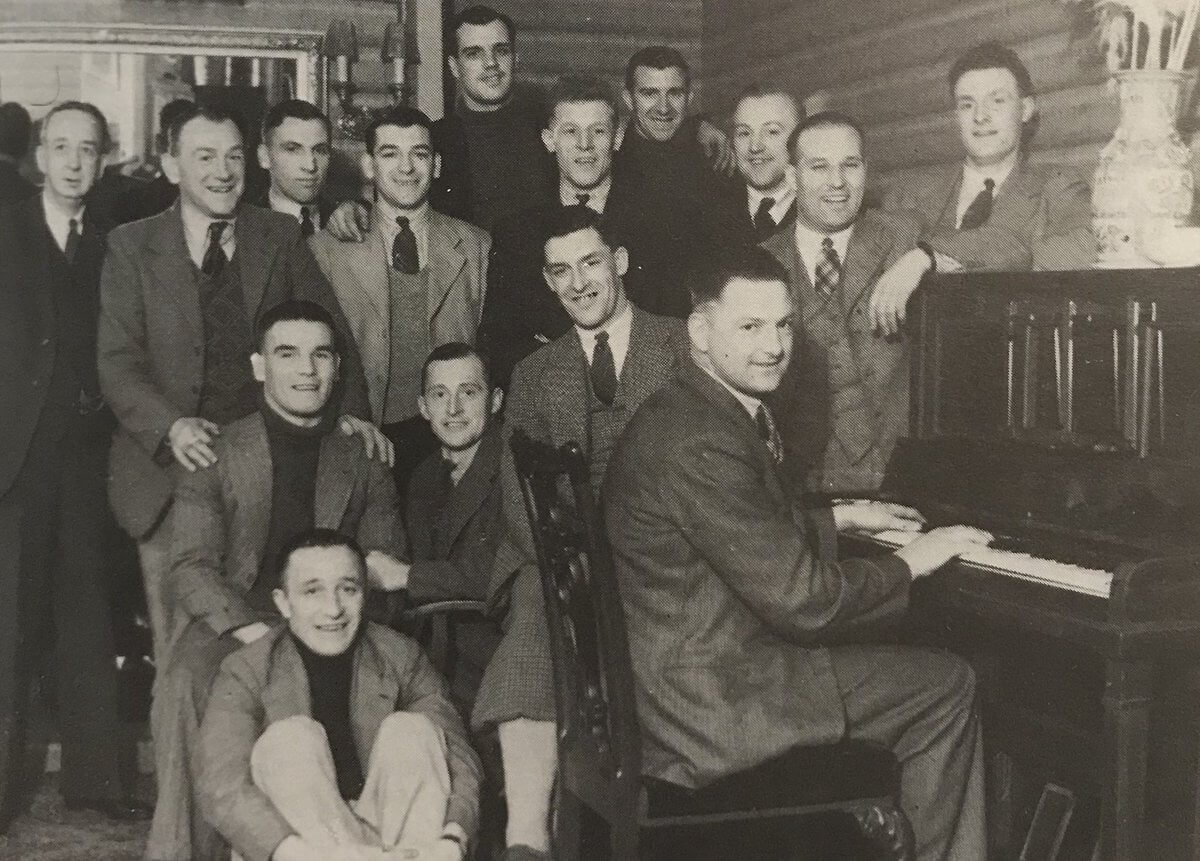
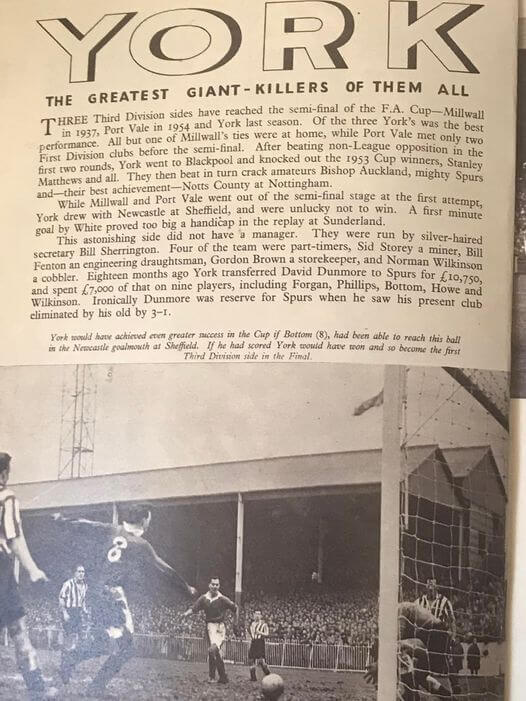
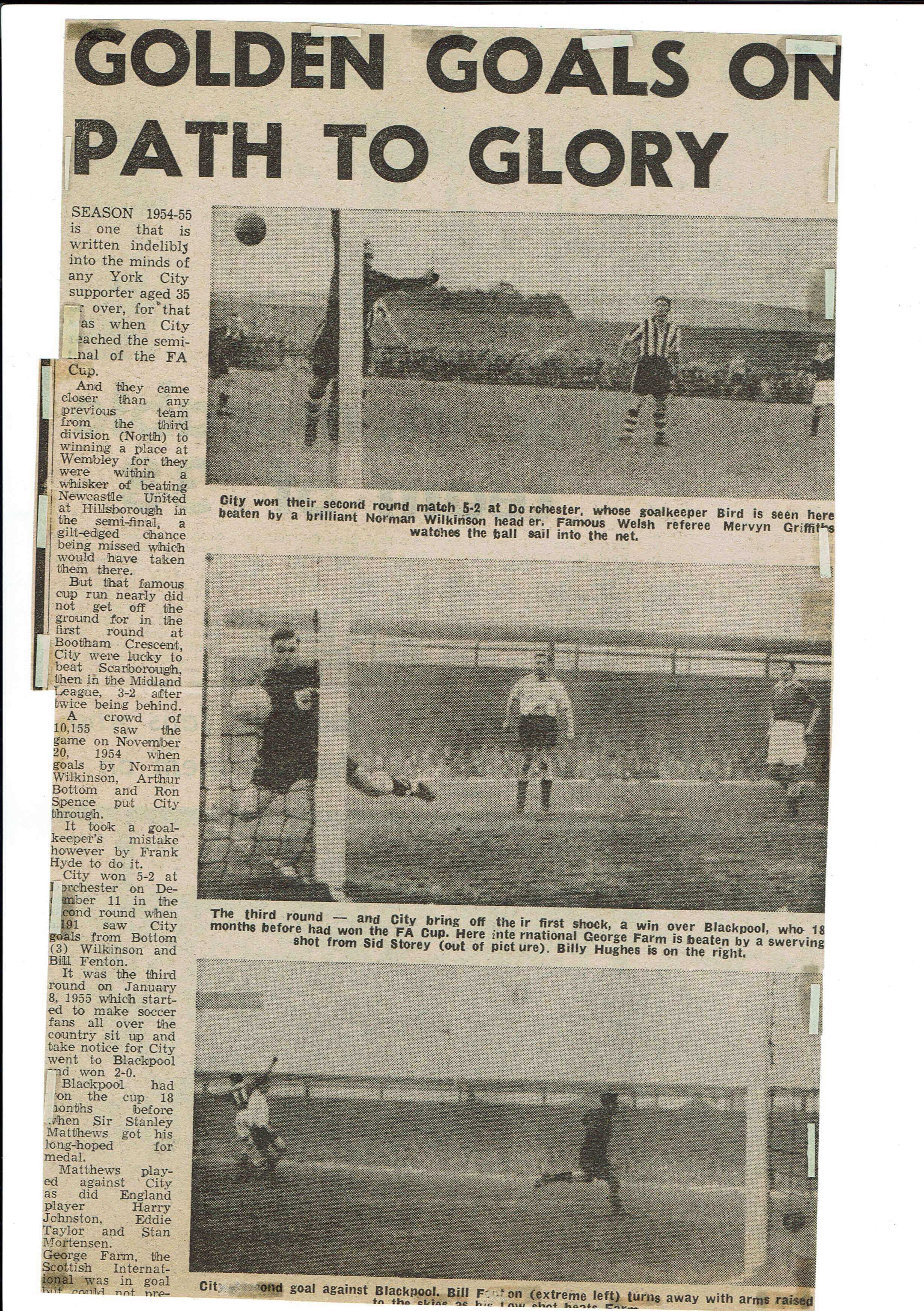
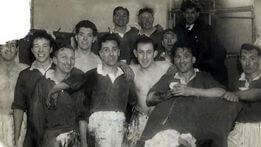
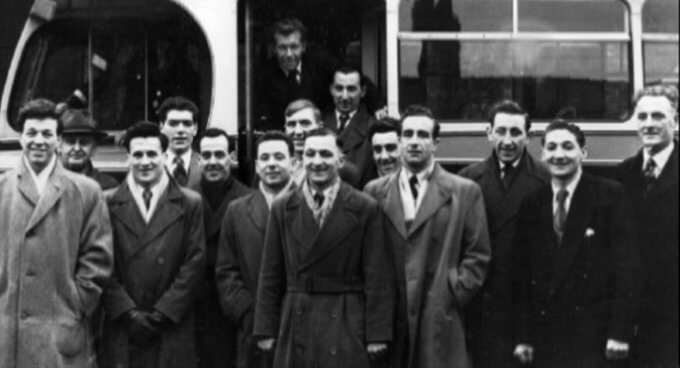
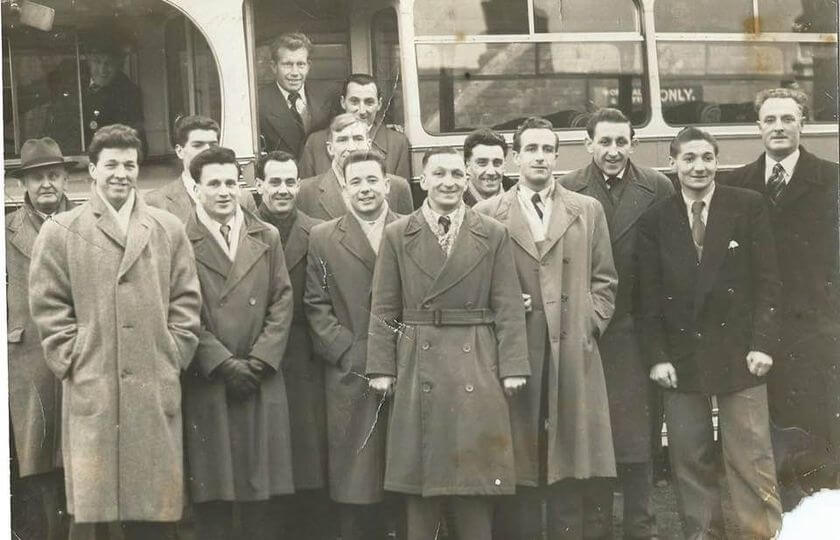
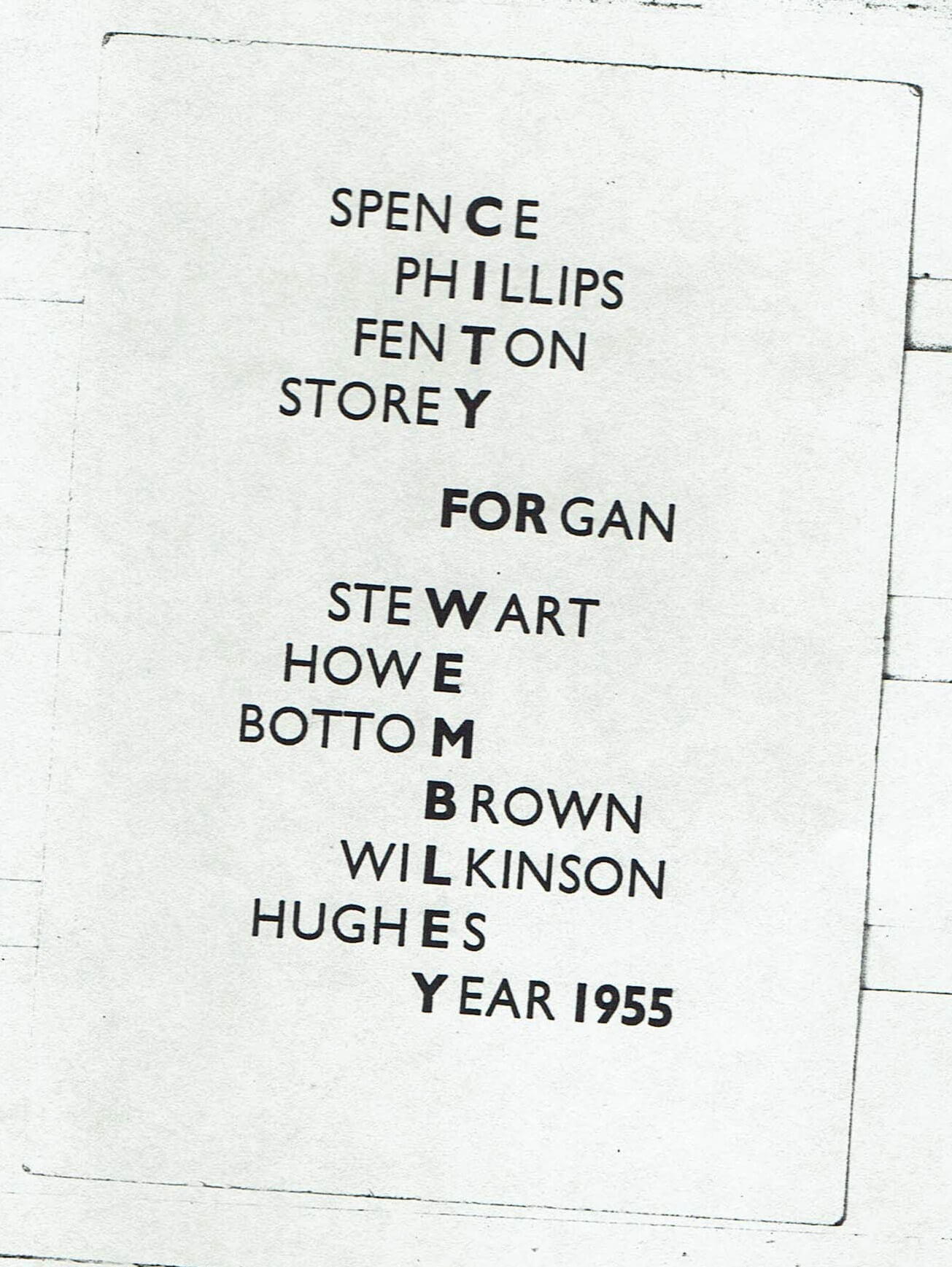
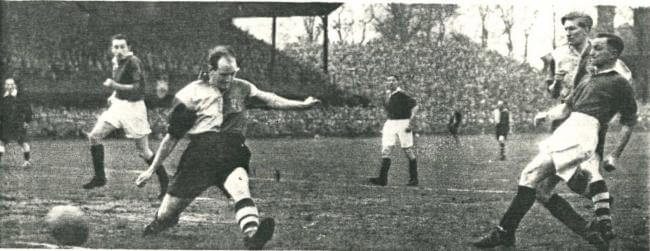
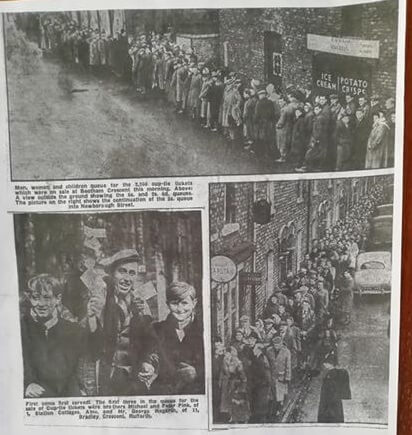
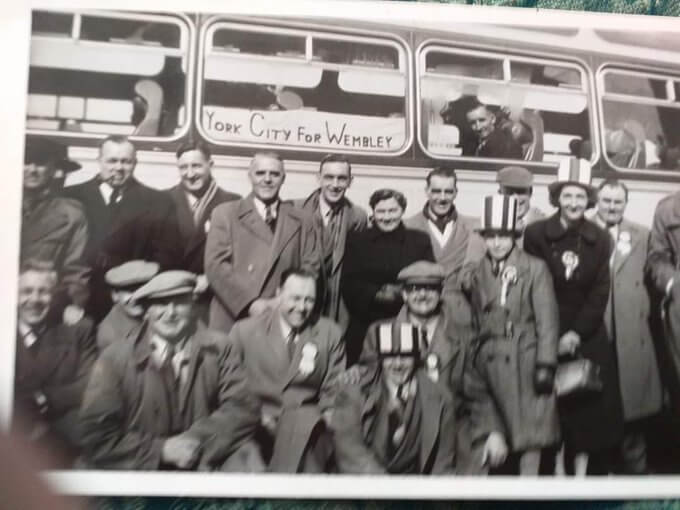
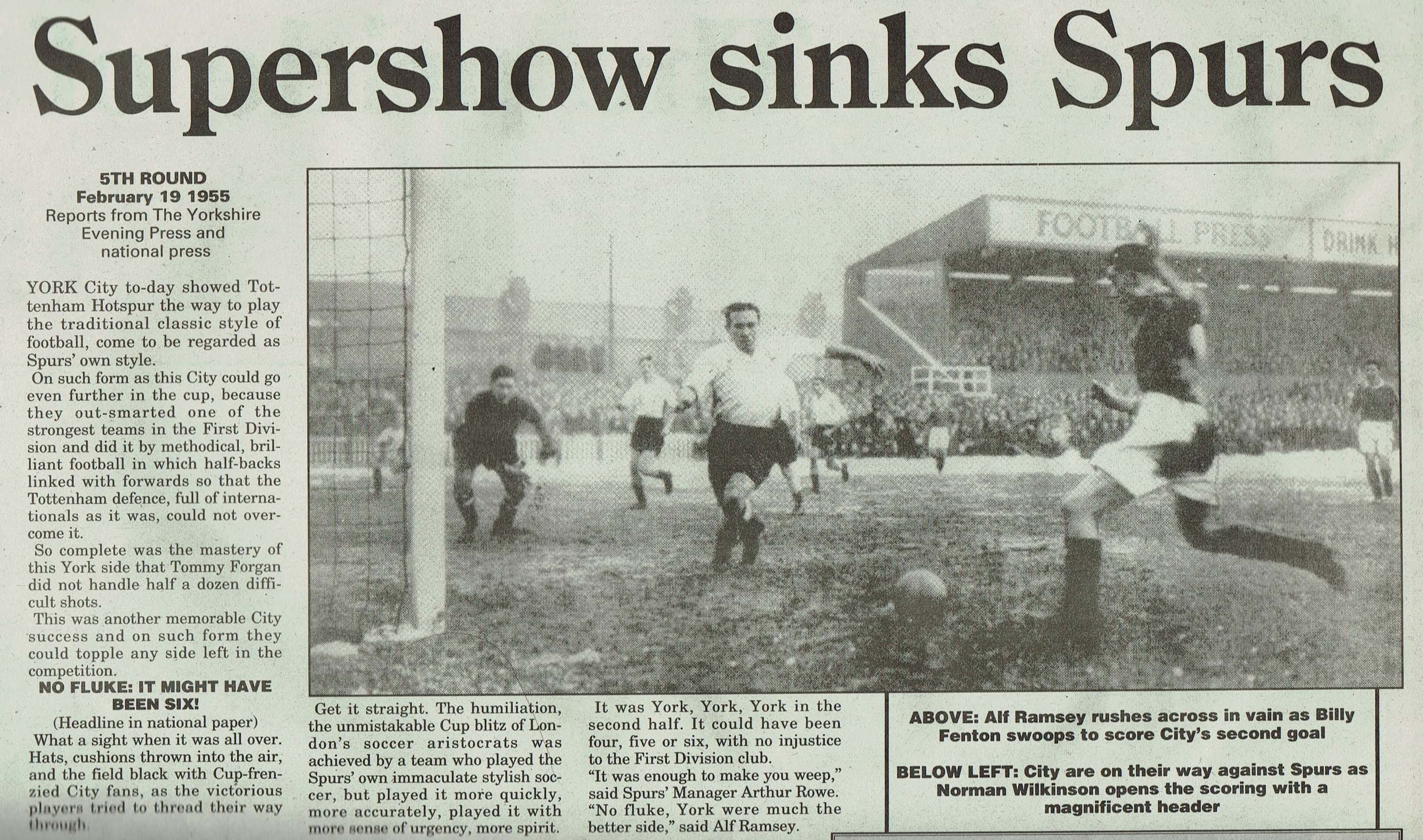

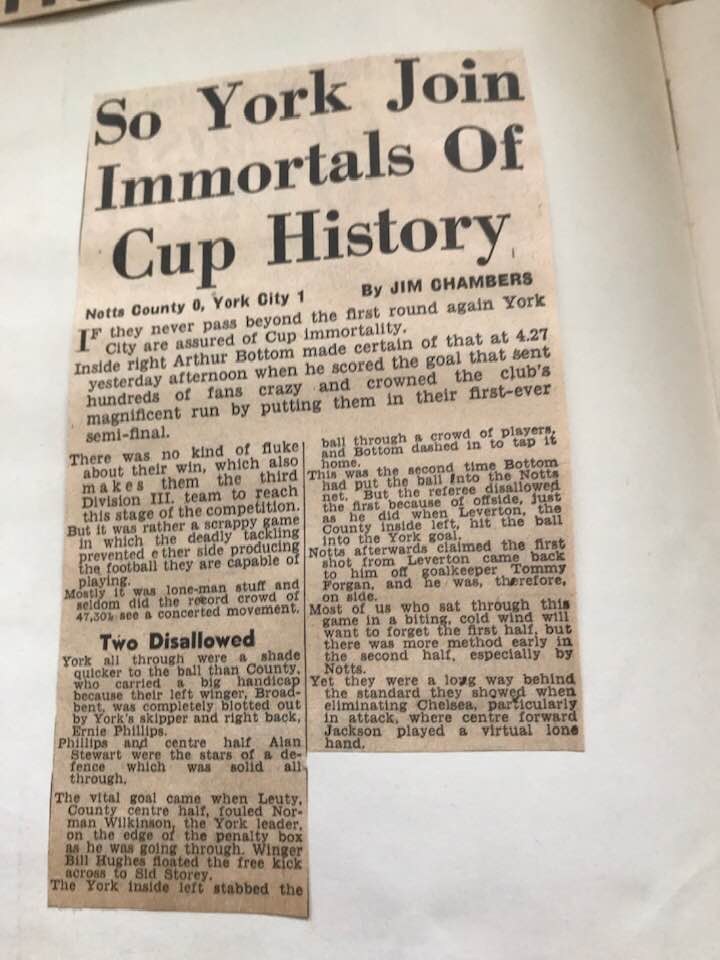
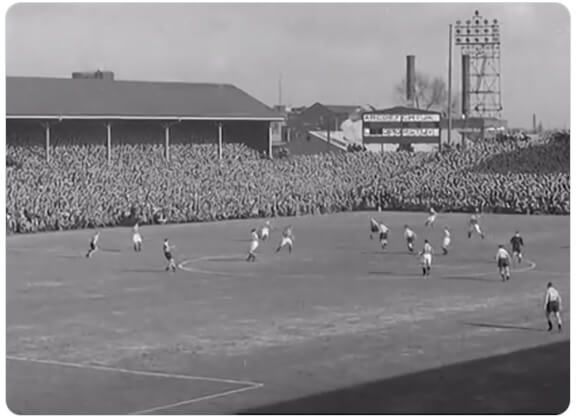
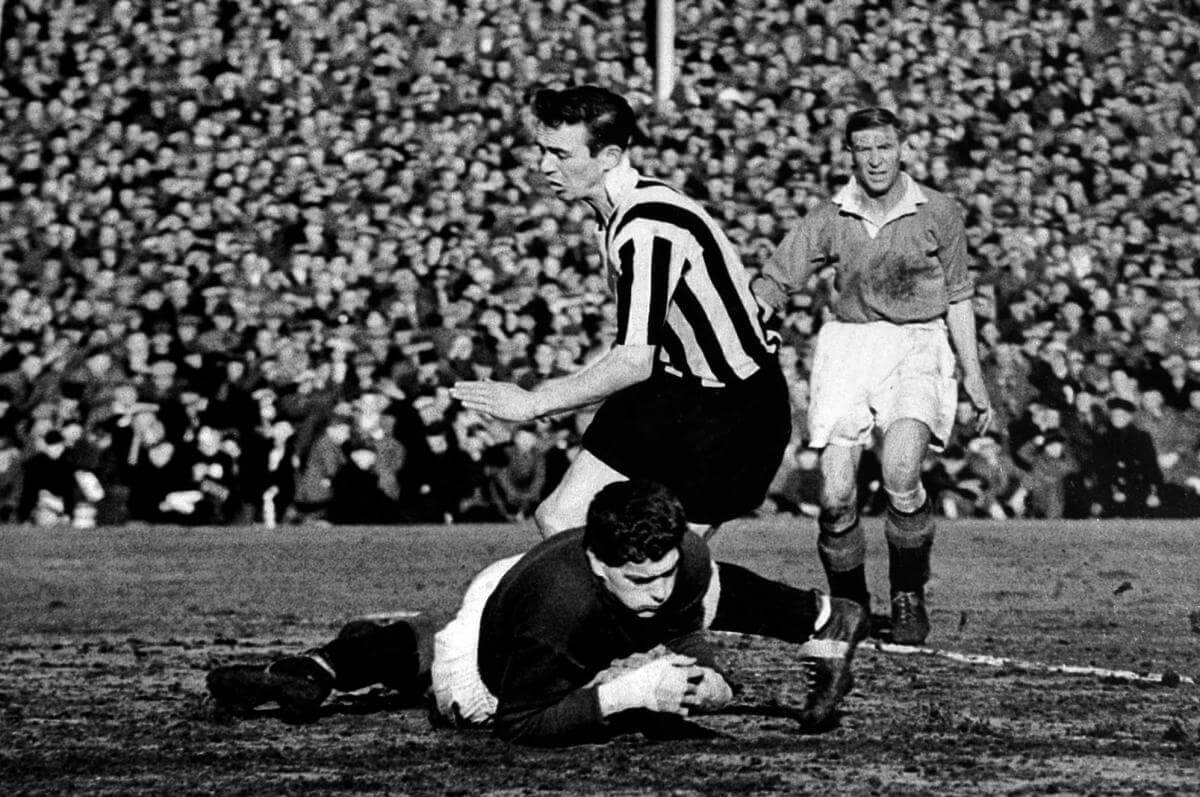
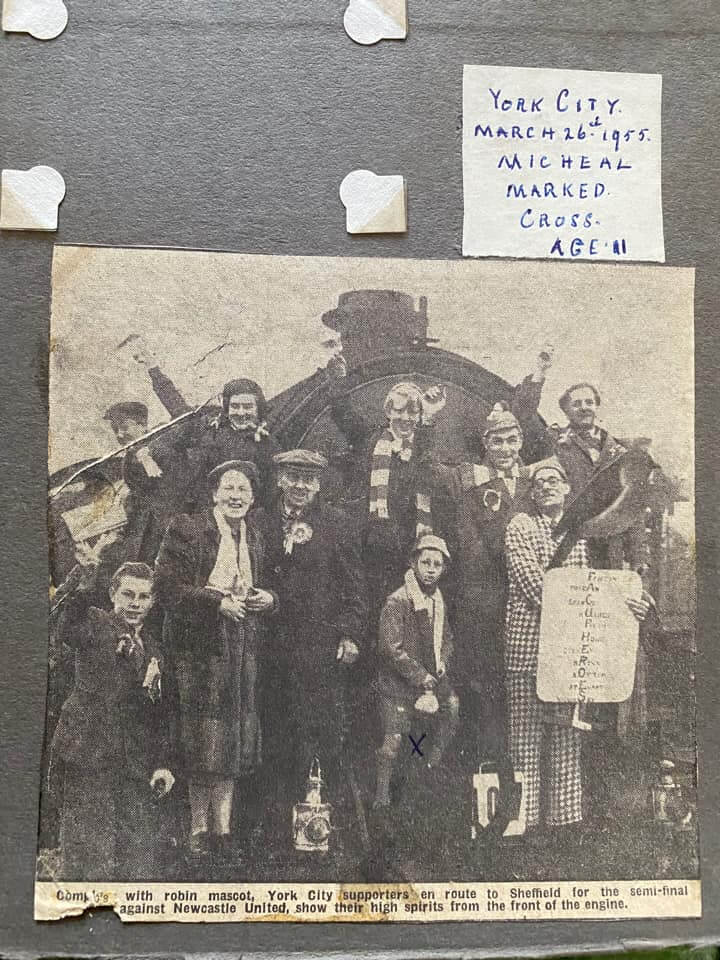
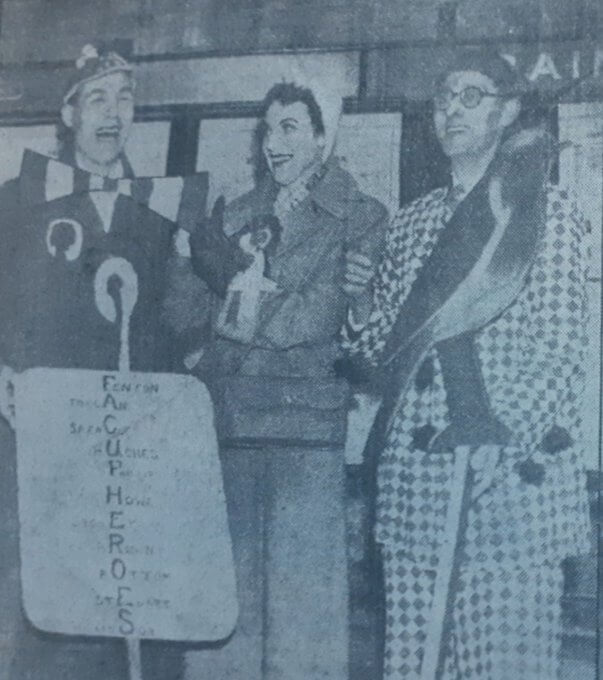
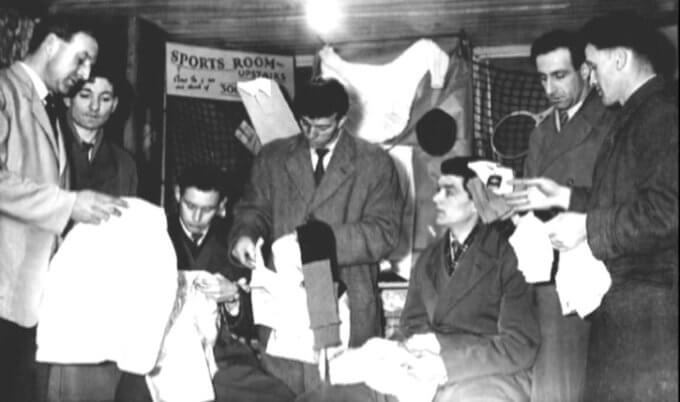
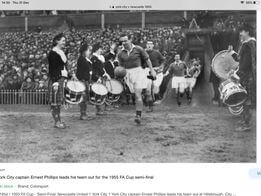

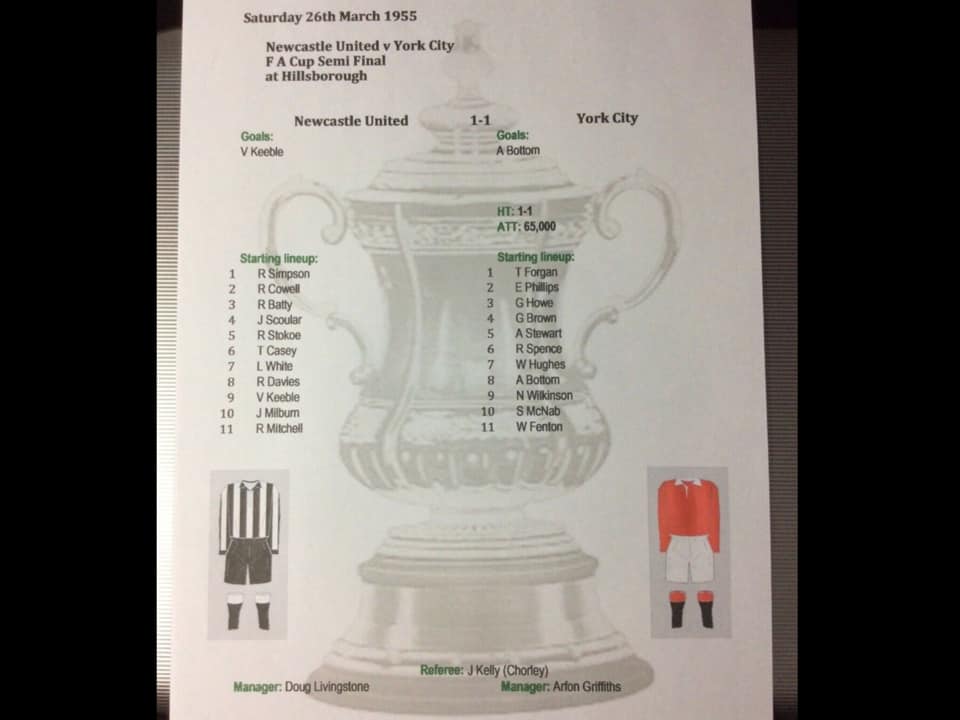
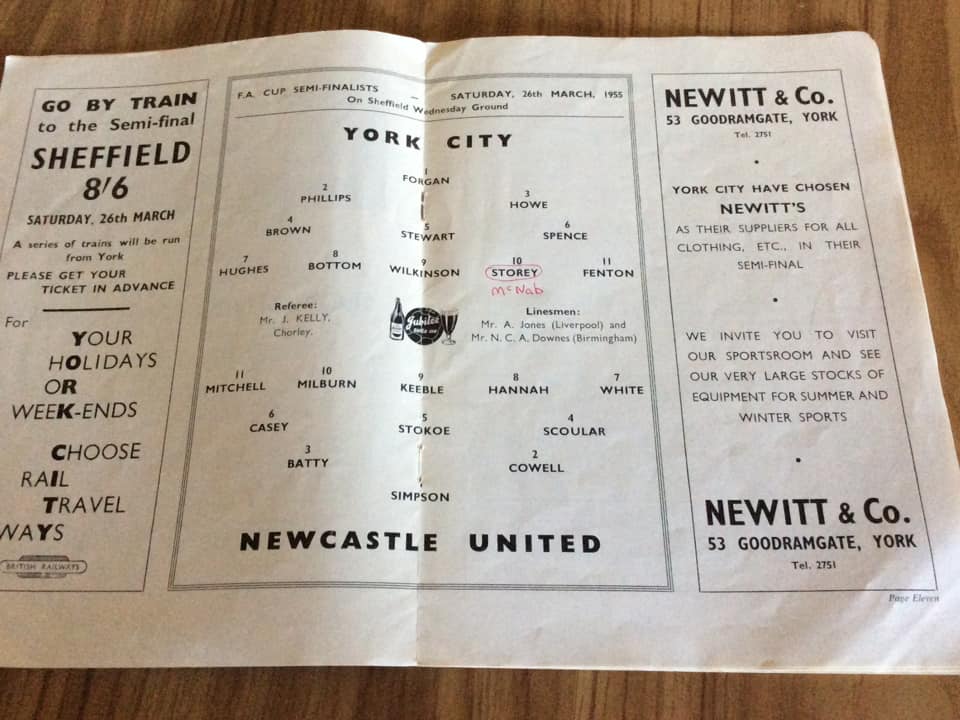
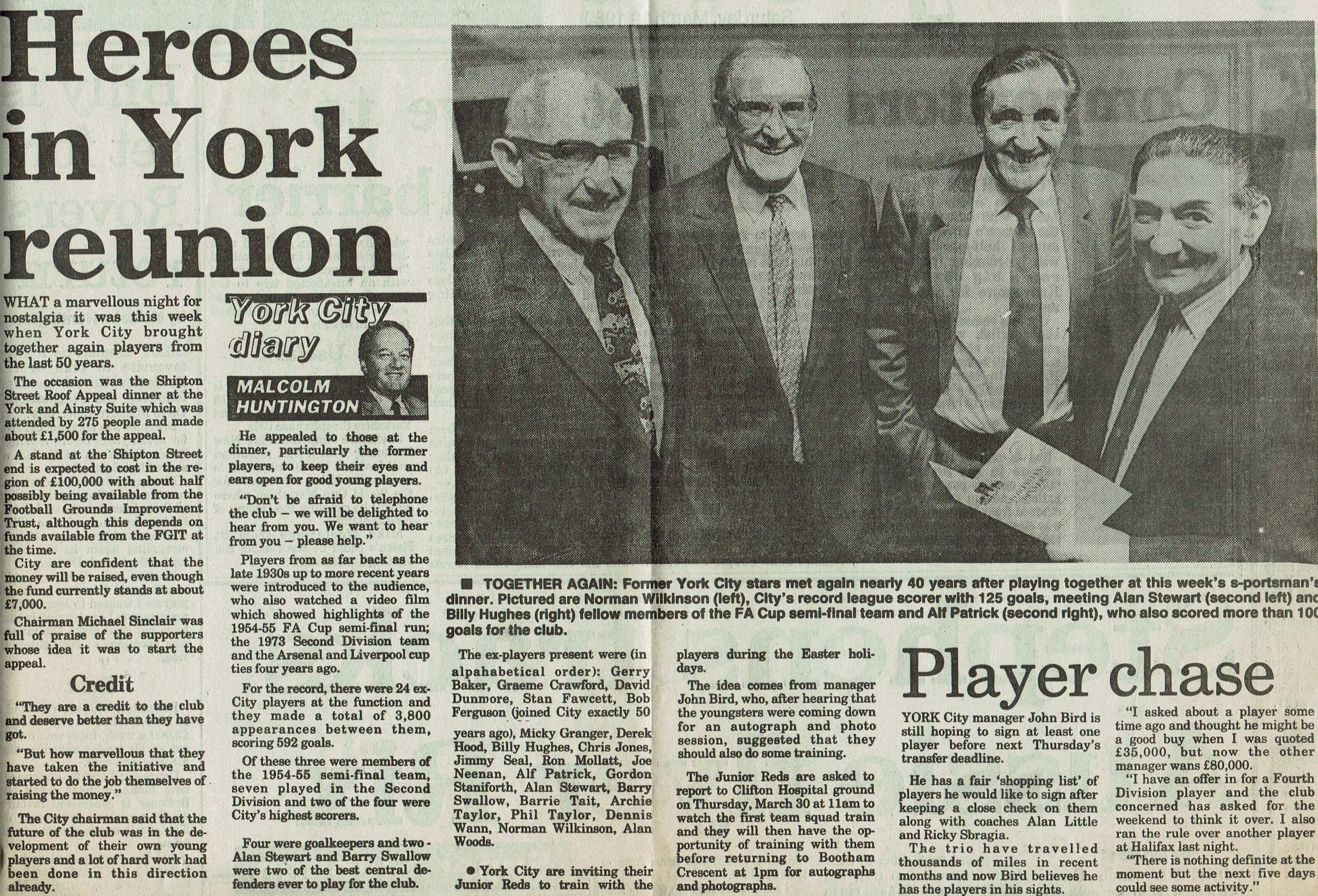
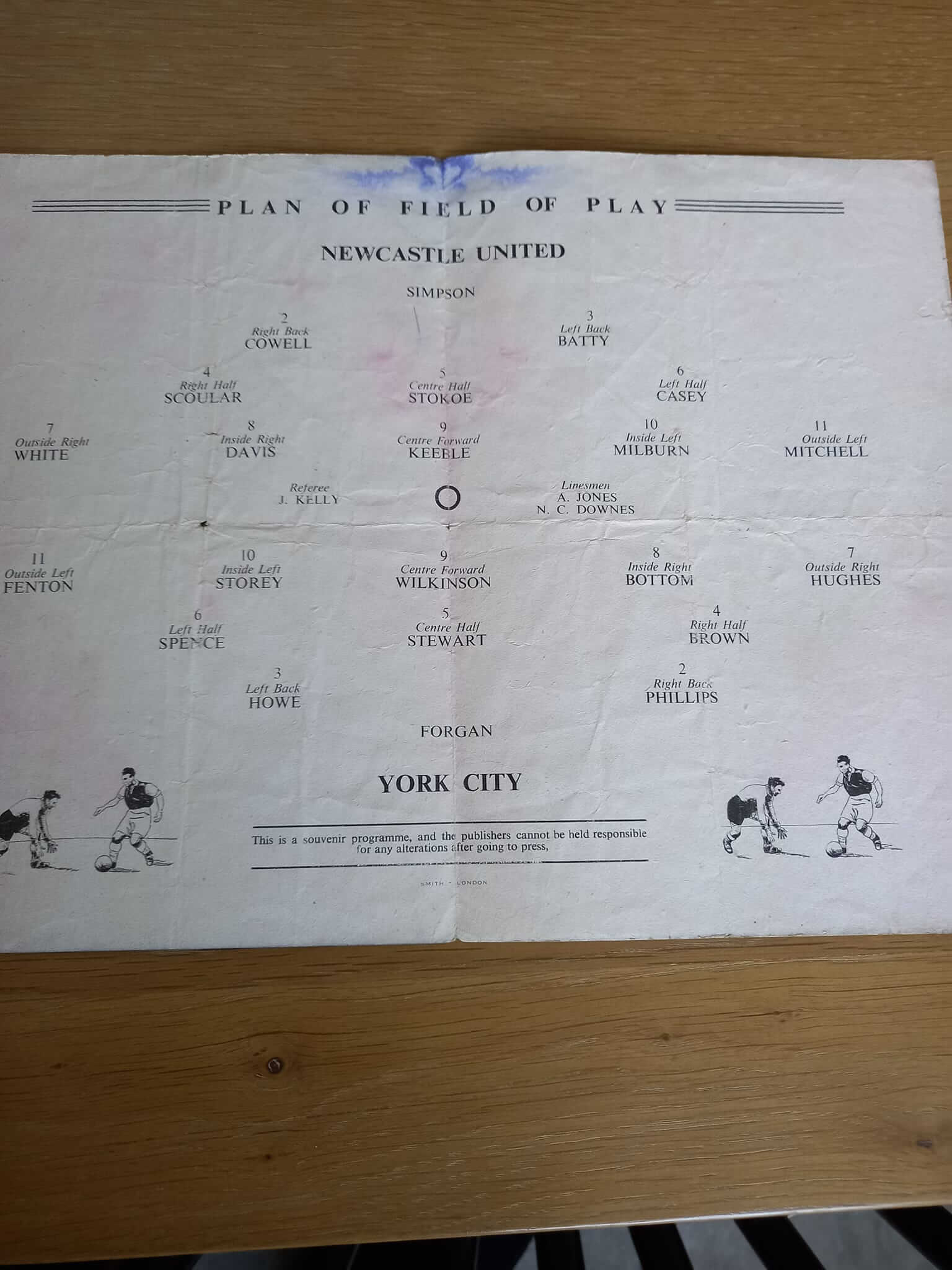
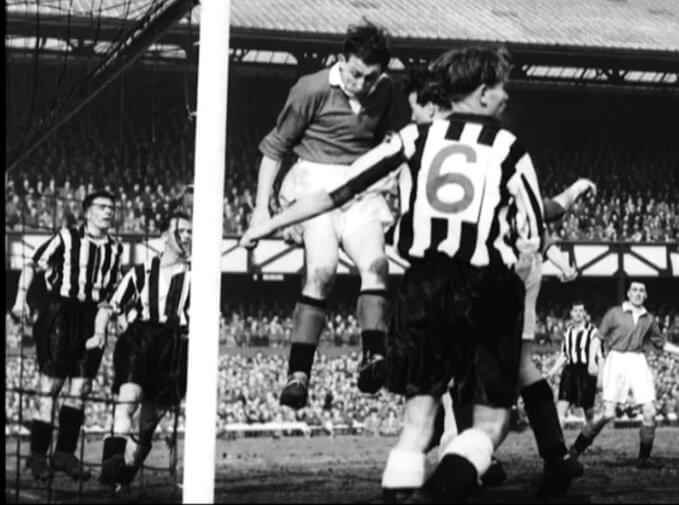
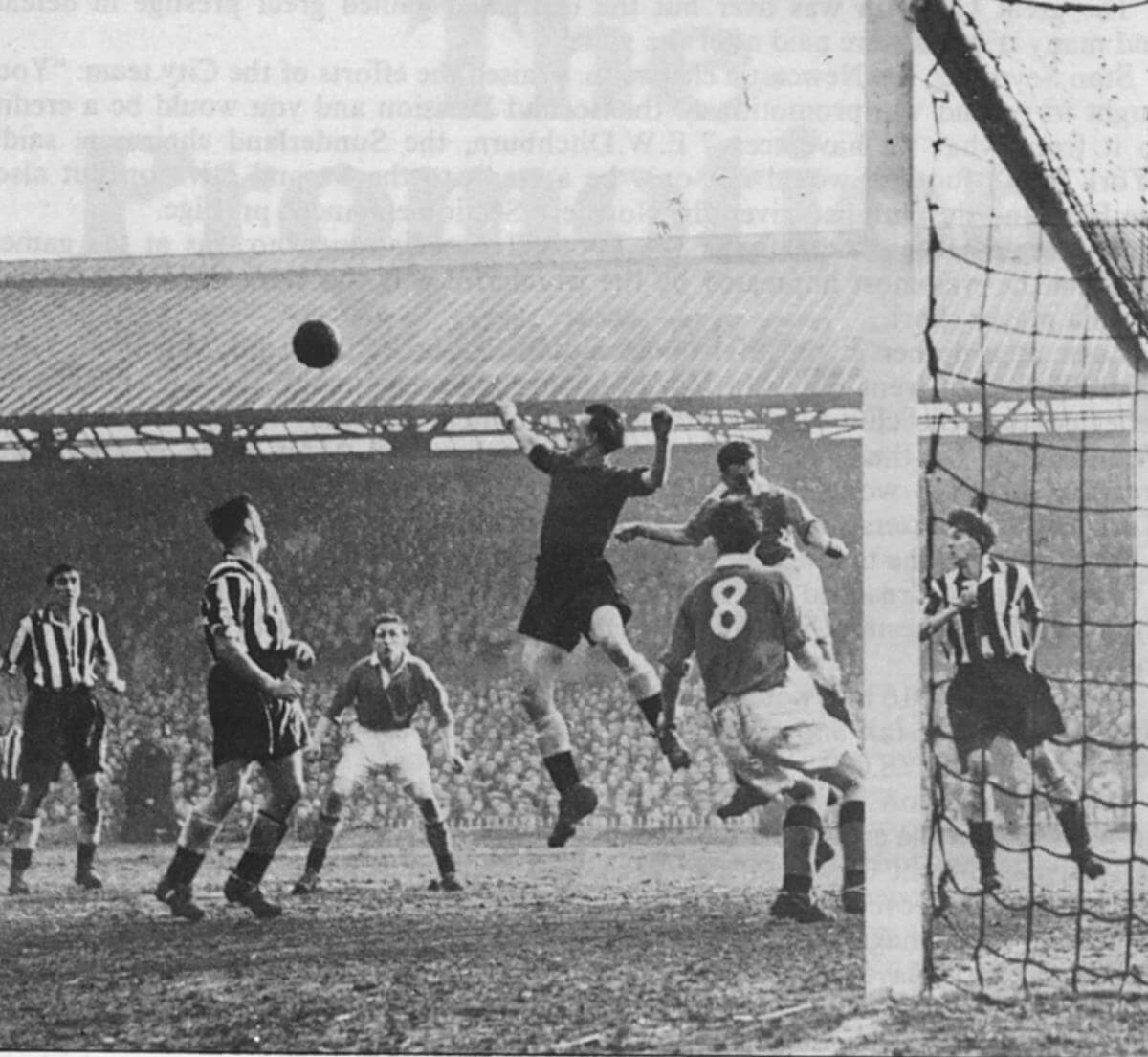
British Movietone were also there and this film shows all the action. Notts on the offensive and seen opening the attack. Tommy Forgan, York goalie makes a save. Now York fight back. Second half - York attacking the Notts goal. The winning goal which Arthur Bottom scores from a mix-up involving Bill Hughes and Sid Storey. The crowd surge onto the pitch to congratulate the 3rd Division winners."

